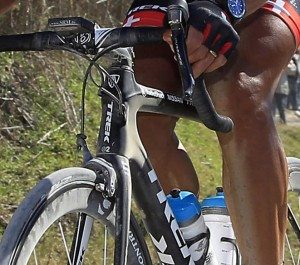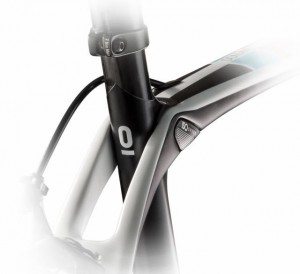For years, companies have put special bikes under their sponsored riders specifically designed for the cobbled classics. Varied geometries, more tire clearance, increased brake clearance and better vibration damping are all some of the reasons for modifying bikes for the cobbles. Even though mechanics still have tricks up their sleeve for use while building “classics” bikes, the occurrence of “one off” or “team only” bikes has been fading with recent UCI regulations which require pro teams to ride bikes that can be purchased by the average joe. Essentially, this has forced development of “comfort” style racing bikes, which one could argue is just a refinement of the “all day” or “sportive” category of bikes that has been around for years. Less aggressive positioning, vibration damping properties and generally more durability are the hallmarks of these bikes which are designed to be ridden by normal people for hours upon end.
 Trek has been one company that has seemingly missed the boat on this fad, at least until now. In the past few days, details have been released about the Domane, which is designed to “specifically addresses the challenges of rough road conditions found throughout the spring classics courses with a collection of key innovations unlike any available before today” according to Trek. Developed with extensive input from Fabian Cancellara, the Domane has a slew of supposed new features that will make it a formidable chariot for Sparticus (and the local Tuesday night racers who love dirt roads, too.)
Trek has been one company that has seemingly missed the boat on this fad, at least until now. In the past few days, details have been released about the Domane, which is designed to “specifically addresses the challenges of rough road conditions found throughout the spring classics courses with a collection of key innovations unlike any available before today” according to Trek. Developed with extensive input from Fabian Cancellara, the Domane has a slew of supposed new features that will make it a formidable chariot for Sparticus (and the local Tuesday night racers who love dirt roads, too.)
frame design
 Like the Madone (of which Domane happens to be an anagram) the Domane is constructed using Trek's OCLV carbon process. It utilizes the Trek BB90 bottom bracket design and internal cable routing (which is almost standard fare on any high end frameset these days.) Interestingly, Trek calls the new cable routing “race optimized” and all the cables enter the frame on the same side of the head tube. It'll be interesting to see if this is retained with the launch of the next Madone or if it's exclusive to the Domane. The fork is redesigned as well, presumably with better damping characteristics and a more aggressive rear sweep of the dropouts (to offset the increased head tube angle.) Skinny seat stays and an integrated chain catcher also appear, reinforcing this bike's intention as a classics-esque machine.
Like the Madone (of which Domane happens to be an anagram) the Domane is constructed using Trek's OCLV carbon process. It utilizes the Trek BB90 bottom bracket design and internal cable routing (which is almost standard fare on any high end frameset these days.) Interestingly, Trek calls the new cable routing “race optimized” and all the cables enter the frame on the same side of the head tube. It'll be interesting to see if this is retained with the launch of the next Madone or if it's exclusive to the Domane. The fork is redesigned as well, presumably with better damping characteristics and a more aggressive rear sweep of the dropouts (to offset the increased head tube angle.) Skinny seat stays and an integrated chain catcher also appear, reinforcing this bike's intention as a classics-esque machine.
As for geometry, you'll find a shortened top tube, taller head tube and longer wheelbase all of which translates into a more comfortable position and a more stable handling machine, which is especially beneficial on rough roads. Trek is offering three geometry variants, H1-3, with H1 being the most aggressive and becoming more relaxed up the line.
 IsoSpeed
IsoSpeed
The big chirping about the Domane comes from the hardware around the seat tube junction. Most mountain bikers will recognize the design as a single pivot suspension linkage, but Trek calls it IsoSpeed. Basically, it's a decoupling of the seat tube and top tube. But what's the point of the pivot? Well, the bearings and axle act as a fulcrum over which the entire seat tube can flex, independent of the top tube. Basically, the flexing seat tube isolates the rider's weight and how his/her weight affects the bike upon hitting bumps, cobbles, potholes, etc. It allows the bike to flex underneath the rider without transmitting shock through their body. It also helps to keep the wheels in contact with the ground, maintaining stability. This essentially makes the Domane a very comfortable race bike, according to Trek product manager Ben Coates. In fact, Trek claims IsoSpeed gives about twice the vertical compliance of any competitor, yet increases lateral rigidity over their own Madone 6 series frame by about 5%. More information can be found in the following video from Trek:
cost?
While it's not the most expensive machine out there, you can certainly lighten your wallet a fair bit if the Domane strikes your fancy. Supposedly you'll be paying around $11,500 for the 6 series Team Edition, while the 6 Series Custom will set you back around $5,200. That's a pretty large jump just to be seen riding the same chariot as Sparticus, but if that's what it takes to get you riding, then godspeed.
In reality, we still don't know how it handles the terrain it was specifically designed for, since Fabian Cancellara crashed out of de Ronde with 60k to go: maybe it will make an impression in Paris Roubaix?